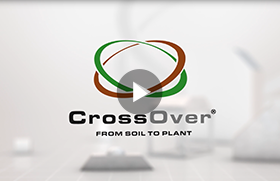Protect your horticulture crop with CrossOver's soluble silicon
Producers of horticultural crops face ongoing challenges to maintain plant health and development. For managers of wholesale ornamental nurseries and fruit and vegetable growers, input costs and risks are high. From fertilizer inputs to irrigation to management of insects and disease, production decisions must be spot on. The margin for error is slim, and plant stress can mean the difference between profit and loss.
CrossOver gives you a powerful tool in mitigating that risk. Our proprietary formula of plant-available silicon, calcium and magnesium improves the health of plants and media in a number of ways. CrossOver can be applied to the soil medium or soilless mixes in container stock or in base soil for horticultural field crops.
Once applied, it establishes a reservoir of water-soluble calcium, magnesium and monosilicic acid – the only form of silicon plants can use – providing unique benefits to the soil structure and the plant.
As silicon is absorbed by the plant, it crosses over from its role as a soil amendment and boosts the plant’s natural defense systems to reduce problems caused by salt, disease, and biotic and environmental stresses.
pH balance
Although soilless media offer a number of benefits (uniformity, consistency, drainage, aeration, sterility), they often suffer from pH variation during the growing period.
During crop production, organic compounds are released from roots and in combination with continuous fertigation/irrigation, the growing medium often loses its CEC. Under these conditions, the pH of many substrates can drop below 5.0.
Nutritional problems often occur when the pH of the growing medium is outside the suggested crop range. Poor fertility of acid soilless substrates is due to a combination of manganese, aluminum and iron toxicities and phosphorus, calcium, magnesium and molybdenum deficiencies.
Acidic soil and CEC
CrossOver’s calcium contributes to base calcium cation levels and removes the feedstock hydrogen and aluminum cations on the substrate surface – significantly reducing reserve acidity and increasing CEC.
Metal toxicity
In the medium solution and on substrate particle surfaces, the monosilicic acid molecule (plant-available silicon) complexes with aluminum, iron and manganese, causing immobilization, detoxification and precipitation of these potentially toxic elements.
Monosilicic acid “triggers” the production of malate and citric acid from the root tip. These compounds bind with soluble aluminum and limits its entry into the root. Monosilicic acid also promotes the homogenous distribution of metallic micronutrients, such as manganese, throughout the growing plant instead of concentrating into toxic pools.
Salt
Efforts to regulate water use have resulted in mandates requiring the horticulture industry to use reclaimed and effluent water, making salt a growing issue. Effluent water can be high in sodium, chloride and bicarbonates, and that can cause salt-related stress. Applications of soluble silicon have been shown to significantly increase potassium uptake and reduce sodium uptake under salt stress conditions.


